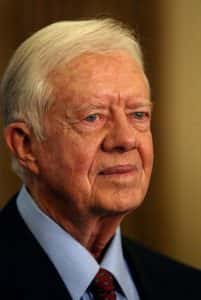![]()
Search ‘US Election 2020’ to see all our coverage
In the run-up to tomorrow’s US Presidential election our student reporting team aims to explore, explain, enlighten and even entertain you on the race for the White House.

DONALD Trump faces the prospect of becoming the first US President this century to be booted out of office after just one term.
Not since George Bush senior in 1992, has an incumbent failed in his re-election bid.
With Trump trailing in the polls, Democrat challenger Joe Biden seems the overwhelming favourite to win next week’s presidential election.
If Biden does triumph, then President Trump will become only the third President who has failed to win a second term since Herbert Hoover in 1933.
Presidents Gerald Ford, Jimmy Carter and George Bush Sr all lost their campaigns for a second term in 1976, 1980 and 1992 respectively.
History shows that sitting presidents tend to secure another four more years – which raises the question: ‘Why do Presidents lose re-election?’

Ford ascended to the presidency following Richard Nixon’s 1974 resignation as a result of the Watergate scandal. Nixon’s resignation shocked the nation to its core, creating a rift between the voters and the governing Republican party
Ford also committed an extraordinary act of self-destruction before his re-election campaign. One month into his presidency, Ford pardoned Nixon, essentially exonerating him of all crimes that may have emerged due to Watergate. The pardon, however, fatally tainted Ford in the eyes of the electorate, which wanted Nixon to answer for his crimes.
Ford lost the presidency – but Nixon may have cost him the election.
For Ford’s successor, Jimmy Carter, the downfall came not just from political issues from his administration, of which there were many, but rather a disastrous campaign to secure his own party’s nomination, which presented Carter to the electorate as a weak leader unable to gain the support from even his own party.
Senator Edward Kennedy, a fellow-Democrat and the youngest child in the Kennedy political dynasty, challenged Carter for the presidency, hoping to force the party to adopt a more progressive stance. While many Democrats agreed with Kennedy, some suspected Carter was in fact a secret Republican and failed to provide any leadership.

Ultimately, Carter managed to hold off the challenge of Kennedy and secured his position as the Democrats’ candidate.
The fractured nature of the Democratic party was in stark contrast to the Republicans, whose nominee was the staunch conservative, Ronald Reagan. The ex-governor of California and former movie star led a slick and well-run campaign full of soundbites (Reagan first used the slogan Make America Great Again).
In the end, Carter was routed, Reagan stormed to the presidency in a landslide and went on to usher in 12 years of conservative administration.
The last President to fail to serve eight years was Reagan’s Vice President, George H.W. Bush.
Bush came into the 1992 election on a wave of positivity, following the success of American coalition forces in the first Gulf War. Some opinion polls, in the run-up to the election, gave President Bush a 89 per cent approval rating.
But the President’s downfall was spectacular, and came from two challenges to his support base: another Republican challenger in the primary campaign, and the unprecedented success of a third-party candidate, Ross Perot, who ate into the President’s vote share when the election came around.
Alongside this, Bush faced external factors such as an economy that had entered recession by 1992, while the Democratic party had nominated a young and exciting Arkansas governor, by the name of Bill Clinton, who was able to galvanise a new support base for the Democrats under his ‘New Democrats’ banner.
While it is impossible to call the election before the results are announced (and with states not declaring until potentially weeks after the election) it seems President Trump faces a fight to ensure he does become a one-term President – and the latest White House tenant to be told ‘You’re fired!‘



